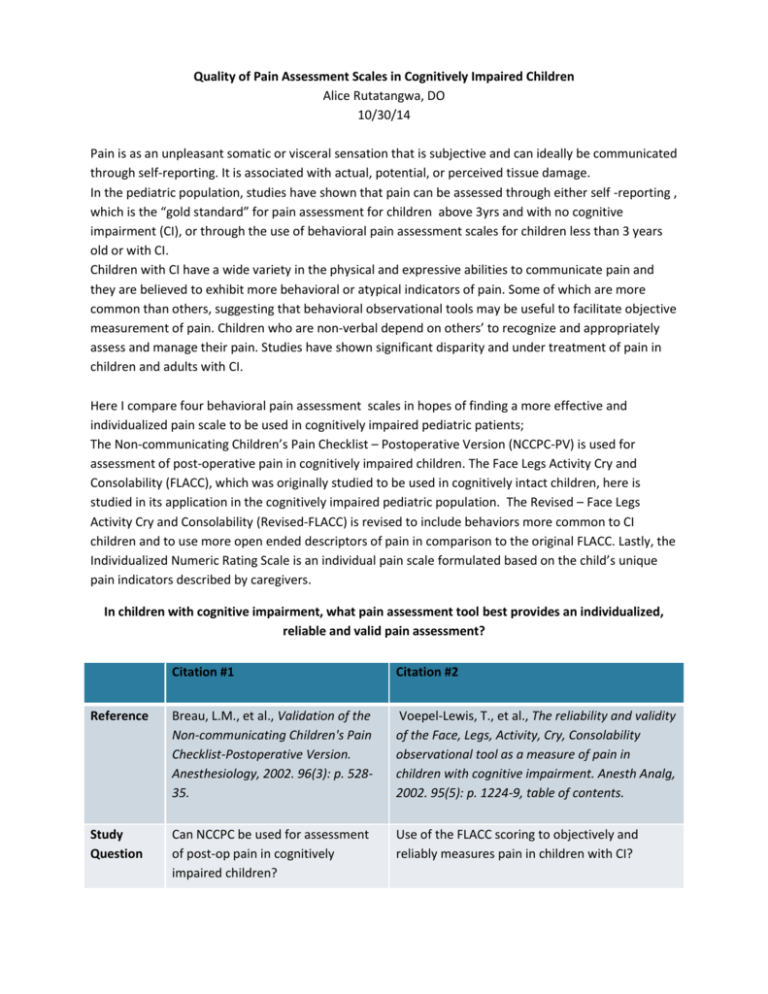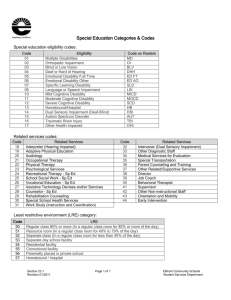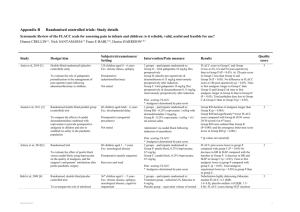Quality of Pain Assessment Scales in Cognitively Impaired Children
advertisement

Quality of Pain Assessment Scales in Cognitively Impaired Children Alice Rutatangwa, DO 10/30/14 Pain is as an unpleasant somatic or visceral sensation that is subjective and can ideally be communicated through self-reporting. It is associated with actual, potential, or perceived tissue damage. In the pediatric population, studies have shown that pain can be assessed through either self -reporting , which is the “gold standard” for pain assessment for children above 3yrs and with no cognitive impairment (CI), or through the use of behavioral pain assessment scales for children less than 3 years old or with CI. Children with CI have a wide variety in the physical and expressive abilities to communicate pain and they are believed to exhibit more behavioral or atypical indicators of pain. Some of which are more common than others, suggesting that behavioral observational tools may be useful to facilitate objective measurement of pain. Children who are non-verbal depend on others’ to recognize and appropriately assess and manage their pain. Studies have shown significant disparity and under treatment of pain in children and adults with CI. Here I compare four behavioral pain assessment scales in hopes of finding a more effective and individualized pain scale to be used in cognitively impaired pediatric patients; The Non-communicating Children’s Pain Checklist – Postoperative Version (NCCPC-PV) is used for assessment of post-operative pain in cognitively impaired children. The Face Legs Activity Cry and Consolability (FLACC), which was originally studied to be used in cognitively intact children, here is studied in its application in the cognitively impaired pediatric population. The Revised – Face Legs Activity Cry and Consolability (Revised-FLACC) is revised to include behaviors more common to CI children and to use more open ended descriptors of pain in comparison to the original FLACC. Lastly, the Individualized Numeric Rating Scale is an individual pain scale formulated based on the child’s unique pain indicators described by caregivers. In children with cognitive impairment, what pain assessment tool best provides an individualized, reliable and valid pain assessment? Citation #1 Citation #2 Reference Breau, L.M., et al., Validation of the Non-communicating Children's Pain Checklist-Postoperative Version. Anesthesiology, 2002. 96(3): p. 52835. Voepel-Lewis, T., et al., The reliability and validity of the Face, Legs, Activity, Cry, Consolability observational tool as a measure of pain in children with cognitive impairment. Anesth Analg, 2002. 95(5): p. 1224-9, table of contents. Study Question Can NCCPC be used for assessment of post-op pain in cognitively impaired children? Use of the FLACC scoring to objectively and reliably measures pain in children with CI? Study Design Non-randomized, non-blinded, crosssectional study Randomized, investigator blinded prospective cohort study Validity +/- Yes? Results Good reliability for facial and vocal subclasses, ICC 0.77 and 0.81, overall reliability was ok Validity? Reliability? Validity: Good correlation between nurses’ and parents VAS. Good correlation of the FLACC in the face and cry categories, limited in legs and activity. Limitations Small sample size Subjects with severe CI (no variations) Specific pain assessment for acute pain only during post-op period Study performed to assess acute post-op pain, hence limited in generalizing its use in other settings Knowledge of patient’s physical status influenced FLACC scores (parents vs. bedside nurse vs. observers) Citation #3 Citation #4 Reference Malviya, S., et al., The revised FLACC observational pain tool: improved reliability and validity for pain assessment in children with cognitive impairment. Paediatr Anaesth, 2006. 16(3): p. 258-65. Solodiuk, J.C., et al., Validation of the Individualized Numeric Rating Scale (INRS): a pain assessment tool for nonverbal children with intellectual disability. Pain, 2010. 150(2): p. 231-6. Study Question Use of the revised FLACC pain assessment tool (including behaviors specific to those with CI) in the assessment of pain in this population Is it feasible to create a usable parentguided INRS for nonverbal children with intellectual disability Study Design Randomized, investigator blinded prospective cohort study Randomized, prospective cohort study Validity Yes Yes Results High reliability: ICC 0.75 – 0.87, with total score 0.9 and Validity with strong correlations (> 0.65). High reliability: ICC 0.82 – 0.87 and Validity: r>0.6 for usefulness as painassessment tool. Limitations Used to assess acute post-op pain Unique/ individualized pain behaviors will need to be known by nurses and not all can be accounted for in the scale Small sample size Subjects with severe CI (no variations) Specific pain assessment for acute pain only during post-op period Application For pain assessment in children with different levels of cognitive impairment, during post-operative care or any acute painful event in a clinical setting For pain assessment in non-verbal children with severe cognitive impairment, during post-operative care or anticipated painful event/ procedure Clinical Bottom Line Revised FLACC can provide a standardized , yet more suited pain assessment tool in children with CI as it incorporates behaviors that are specific to this population of patients INRS can provide a standardized, yet individualized pain assessment tool in children with CI Bottom line: recommended and validated pain scales for use: The Revised FLACC provides a more standardized and yet specific pain assessment that can be applied in a broad range of cognitive impaired children, and can easily be used in a clinical setting even when the child’s specific pain descriptors are unkown. The INRS also provides a standardized and individualized pain assessment tool, however its application is limited with the reliance in the caregiver’s knowledge child’s specific/ unique pain behaviors and its use was studied in children with significant cognitive impairment. References: Breau, L.M., et al., Validation of the Non-communicating Children's Pain Checklist-Postoperative Version. Anesthesiology, 2002. 96(3): p. 528-35. Breau, L.M., et al., Psychometric properties of the non-communicating children's pain checklistrevised. Pain, 2002. 99(1-2): p. 349-57. Malviya, S., et al., The revised FLACC observational pain tool: improved reliability and validity for pain assessment in children with cognitive impairment. Paediatr Anaesth, 2006. 16(3): p. 258-65. Solodiuk, J. and M.A. Curley, Pain assessment in nonverbal children with severe cognitive impairments: the Individualized Numeric Rating Scale (INRS). J Pediatr Nurs, 2003. 18(4): p. 2959. Solodiuk, J.C., et al., Validation of the Individualized Numeric Rating Scale (INRS): a pain assessment tool for nonverbal children with intellectual disability. Pain, 2010. 150(2): p. 231-6. Voepel-Lewis, T., et al., The reliability and validity of the Face, Legs, Activity, Cry, Consolability observational tool as a measure of pain in children with cognitive impairment. Anesth Analg, 2002. 95(5): p. 1224-9, table of contents. Voepel-Lewis, T., et al., A comparison of the clinical utility of pain assessment tools for children with cognitive impairment. Anesth Analg, 2008. 106(1): p. 72-8.






